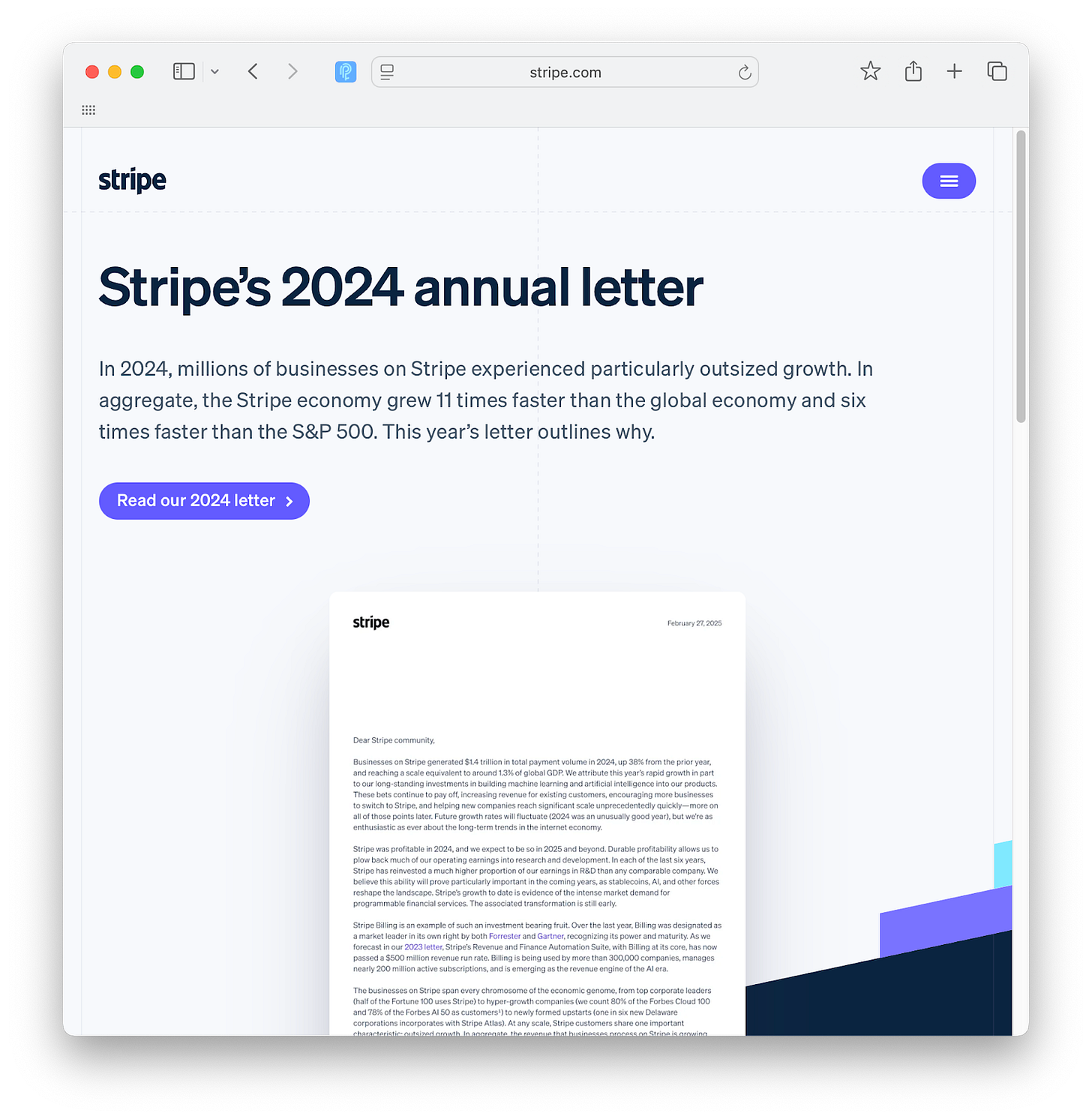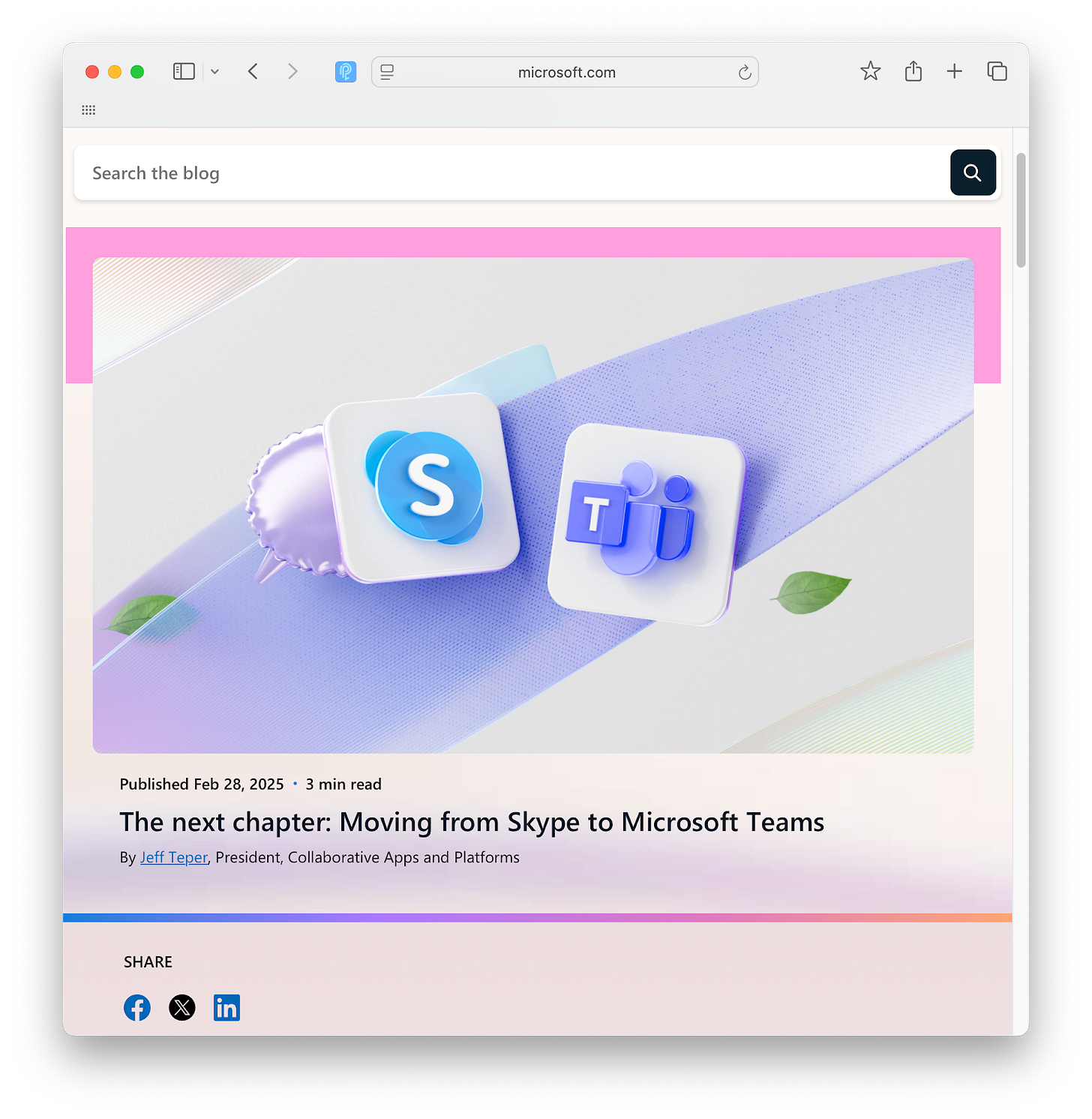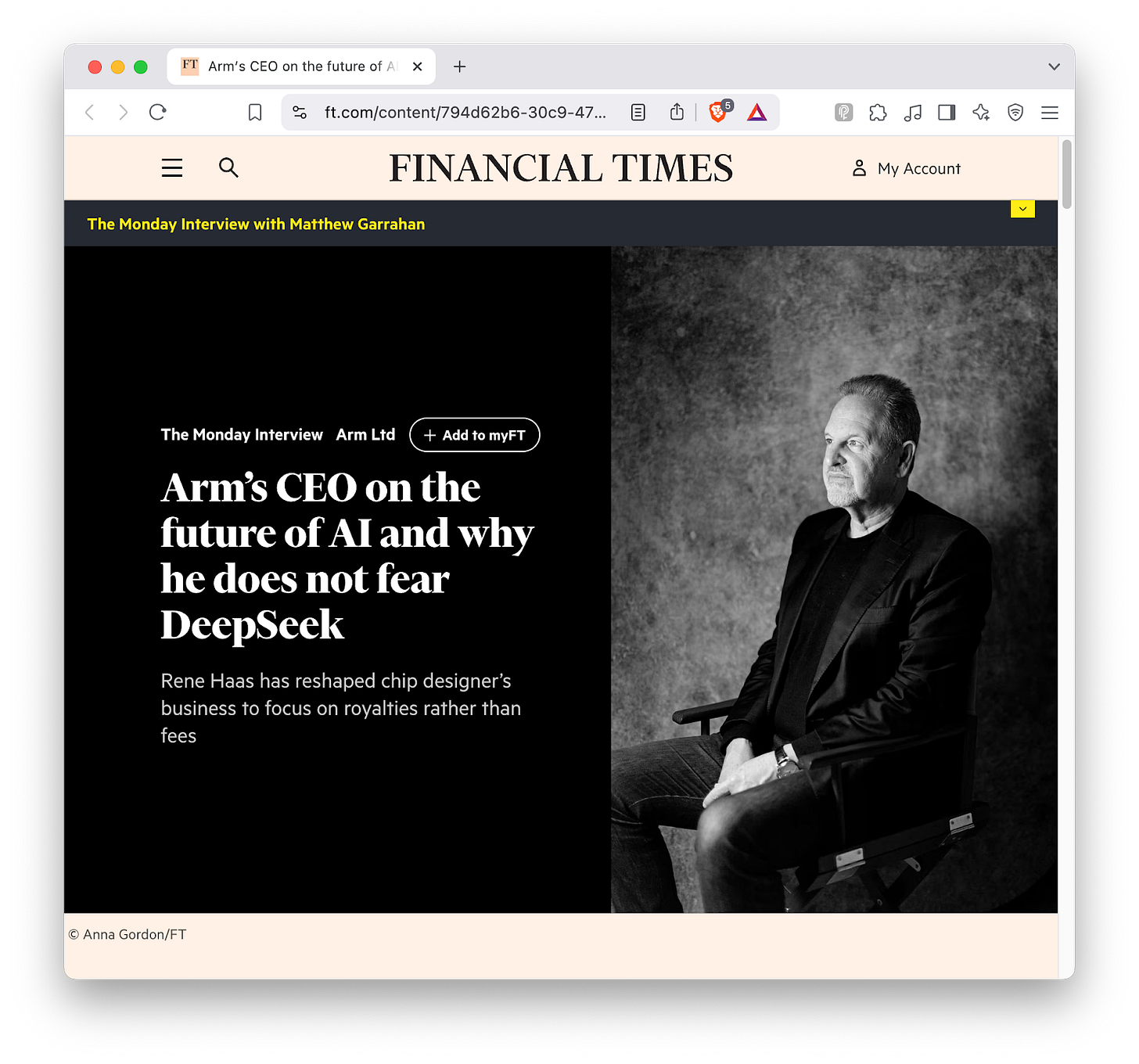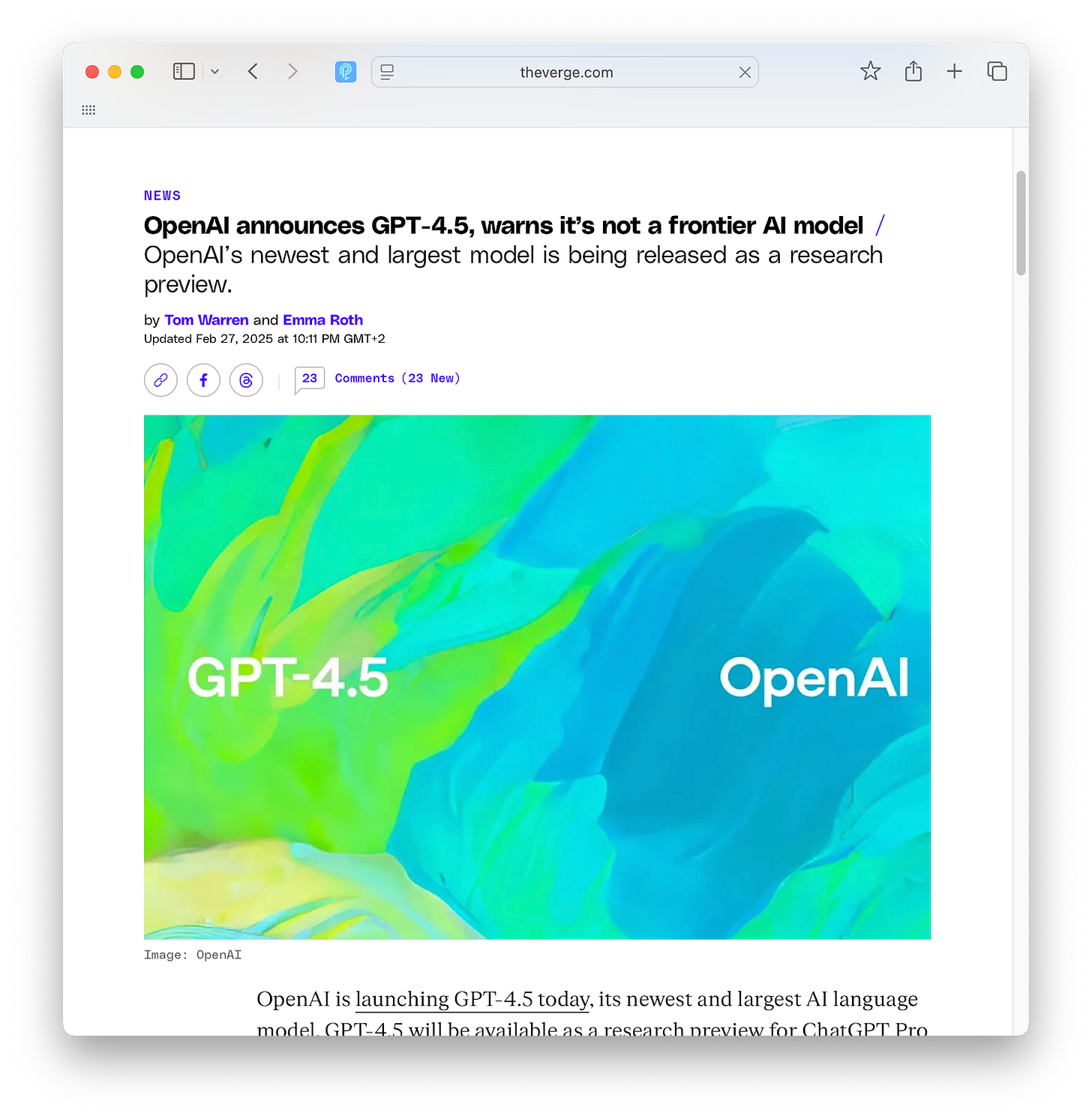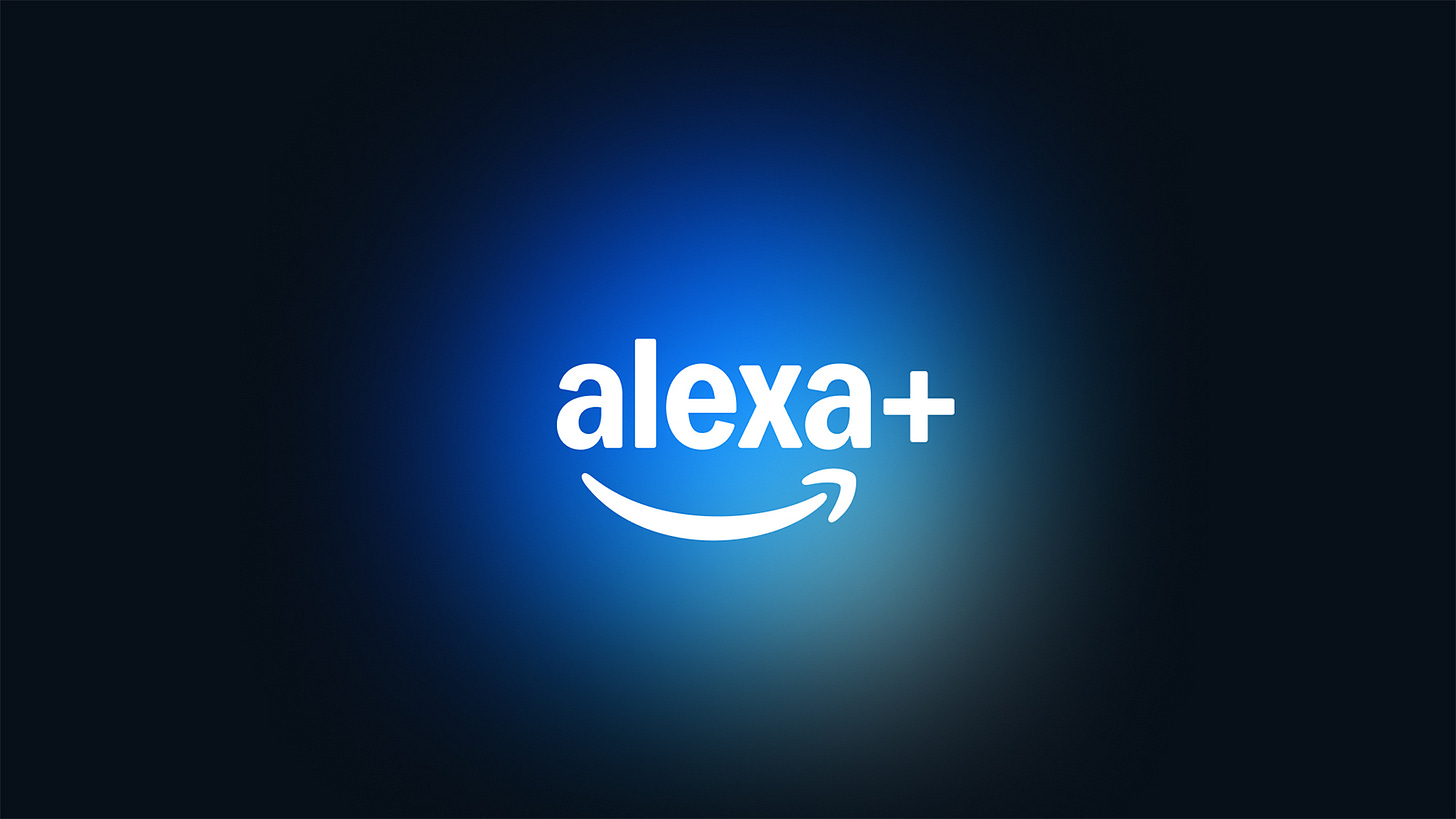(#115) 💳 Stripe’s 2025 Letter explained; ☕️ on Starbucks’ layoffs
The real takeaways of Arm’s CEO interview on the future of AI
Dear #onStrategy reader,
Here is what you’ll find in this edition:
Stripe’s 2025 Letter explained
The rise and fall of Skype
The real takeaways of Arm’s CEO interview on the future of AI
Chat GPT 4.5 is here
There’s a new toy (and subscription) in town: Alexa+
Starbucks’ layoffs: a Wall Street perspective
Stripe’s 2025 Letter explained
For me, Stripe’s annual letter is a moment that I’m waiting for. There are so many leadership and business lessons in each letter. Here are the most important insights for me:
1/ Stripe is no longer just a payments company, it’s an economic engine.
With $1.4 trillion in total payment volume in 2024, Stripe now processes the equivalent of 1.3% of global GDP. That’s a staggering number for a company that started as an API for developers to accept credit cards. But more importantly, it highlights that Stripe is building the financial infrastructure of the internet economy and that economy is growing much faster than traditional industries. Unlike legacy financial institutions, Stripe operates as a programmable platform, which allows its customers to move, transact, and monetize faster than their competitors.
2/ Profitability matters now, but reinvestment still defines Stripe’s strategy.
Stripe was profitable in 2024 and expects to remain so in 2025. This is a big shift from the growth-at-all-costs mentality of the last decade, but it also reflects the new reality of tech: profitability is power. However, instead of hoarding cash or distributing dividends, Stripe is doubling down on reinvestment into R&D at an industry-leading rate. This is particularly relevant given the emerging trends in stablecoins, AI and financial automation, all areas where Stripe wants to dominate before others catch up.
3/ Billing is becoming a core part of Stripe’s future.
While Stripe started with payments, subscription billing is becoming its next major revenue driver. Stripe Billing is now a $500 million business, used by over 300,000 companies, and managing 200 million active subscriptions. The real significance? Billing isn’t just about collecting recurring payments, it’s about automating revenue operations for the AI era. Companies are increasingly embedding machine commerce, and Stripe is positioning itself as the default financial infrastructure for this transition.
4/ Legacy companies are modernizing with Stripe, and that’s a huge deal.
It’s easy to think of Stripe as a platform for startups, but half of the Fortune 100 are now customers. The company highlights organizations that have been around for centuries, like Oxford University, the Church of England, and PepsiCo, now running digital payments through Stripe. This shift reflects a broader truth: every company, regardless of age, must now operate like a software company. Stripe it’s giving legacy enterprises a way to reinvent themselves before they get disrupted.
5/ AI-native businesses are growing at an unprecedented pace.
Stripe’s letter is filled with AI-related stats, but one stands out: more than 700 AI agent startups launched on Stripe last year. Companies like OpenAI, Perplexity, and ElevenLabs aren’t just using Stripe to process payments, they’re building AI-native business models that depend on instant, automated transactions. The broader implication? AI is fundamentally changing how businesses interact with money, and Stripe is making sure it owns the financial layer of this transformation.
6/ Vertical SaaS is the hidden force behind small business growth.
Traditional SMEs are thriving again, not because they’re going digital, but because software is being built specifically for them. Stripe’s letter cites platforms like Slice (for pizzerias), Traxero (for tow truck operators), and Clio (for law firms), all examples of vertical SaaS businesses that act as financial platforms for their industries. This is a fundamental shift: Stripe it’s enabling software-driven economies at every level, including small businesses that previously couldn’t access this kind of technology.
7/ Stablecoins are Stripe’s next big bet, because money itself is changing.
Stripe’s acquisition of Bridge, the leading stablecoin orchestration platform, signals a massive shift in financial infrastructure. Stablecoins make money movement cheaper, faster, and programmable, and Stripe is betting that they will become a core part of business transactions worldwide. While stablecoins have been largely a crypto-native phenomenon, Stripe’s push into the space suggests that they’re about to become mainstream for corporate treasury, global payroll, and real-world commerce, all of which Stripe is already positioned to handle. LINK
The rise and fall of Skype
Some ideas on this topic:
1/ Skype was once the gold standard of internet communication, a prime example of how software could disrupt legacy industries. By leveraging peer-to-peer (P2P) networking, it bypassed traditional telecom infrastructure, making international calls practically free. It scaled rapidly, becoming the default for voice and video calls globally. But like many great consumer technologies, its strength was also its weakness - Skype’s P2P architecture was difficult to maintain and modernize - particularly as mobile became the dominant computing paradigm.
2/ Microsoft’s 2011 acquisition should have been a turning point, but instead, it marked the beginning of Skype’s decline. Unlike Apple’s vertical integration playbook or Google’s relentless iteration, Microsoft mismanaged Skype by prioritizing enterprise integration over consumer experience. Teams took precedence, and Skype’s once-seamless experience was bogged down by UI overhauls, bloatware, and security concerns. Meanwhile, the market shifted: FaceTime, WhatsApp, and Zoom took over by offering simpler, more mobile-friendly alternatives, built from the ground up for the cloud era.
3/ The lesson? Consumer software can’t afford stagnation, even with first-mover advantage. Skype had brand recognition, network effects, and Microsoft’s backing, but it lacked product-market fit in a world moving to mobile-first, cloud-native communication. Microsoft let Skype become a relic of the desktop era, while Zoom, WhatsApp, and even Microsoft’s own Teams stepped in to finish the job. The Skype ringtone may live on in nostalgia, but its relevance is long gone. LINK
The real takeaways of Arm’s CEO interview on the future of AI
Some insights from this interview:
1/ The most interesting part of this interview isn’t that DeepSeek released a surprisingly strong AI model, it’s how Rene Haas views AI’s trajectory and where Arm fits into it. His reaction to DeepSeek’s emergence is telling: he doesn’t buy into the “AI shockwave” narrative and instead points to who is spending the money. In other words, breakthroughs in AI are fascinating, but real power lies in capital expenditure. As long as companies like Microsoft, Google, and Meta continue pouring tens of billions into AI infrastructure, the space will keep expanding regardless of short-term disruptions. The DeepSeek news caused panic in markets, but Haas sees AI’s future as a long-term arms race, not a single disruptive event.
2/ This ties into the broader structural shift happening in AI: the commoditization of models vs. the monetization of infrastructure. Open-source AI is getting better, and competition is increasing, but hardware is where the bottlenecks remain. Haas subtly reinforces this by dismissing the idea that DeepSeek built its model for a fraction of OpenAI’s cost. It’s unlikely they magically bypassed the enormous compute and energy demands of training frontier models. This echoes the reality of AI today: inference and deployment costs are dropping, but foundational model training remains heavily dependent on compute and semiconductor innovation, a market where Arm, Nvidia, and a few key players still control the levers.
2/ Finally, Haas’s comment about Washington “scrambling” over DeepSeek is another important signal. AI is not just a technology, it’s a geopolitical asset. Just as the USA government is cracking down on TikTok, there’s a real possibility that Chinese AI models will face regulatory scrutiny, particularly if they gain market share in Western markets. The takeaway? The future of AI isn’t just about better models, it’s about who owns the infrastructure, who sets the rules, and who controls distribution. Haas isn’t worried about DeepSeek because he understands that in the AI race, models come and go, but the platforms underneath them (ie. chips, data centers, and regulatory moats) determine the winners. LINK
Chat GPT 4.5 is here 👀
These are interesting times we are living in. We know that GPT 5 is months away, but let’s take a look below at what is GPT 4.5 means:
1/ The launch of GPT-4.5 is less about technological leaps and more about market positioning. OpenAI is explicitly saying this is not a “frontier” AI model, meaning it’s not pushing the boundaries of reasoning or general intelligence, but rather refining the existing GPT-4 architecture. This suggests a few things: first, OpenAI is trying to maintain engagement and market dominance between major releases. With competitors like DeepSeek and Anthropic rapidly improving, OpenAI needs to keep attention and subscription revenue flowing, especially from Pro and Enterprise users. At the same time, OpenAI is managing expectations. Sam Altman himself admitted that GPT-4.5 “won’t crush benchmarks,” but it does feel more “natural.” This is an iterative improvement, not a revolution.
2/ More interestingly, OpenAI’s language around unsupervised learning vs. reasoning models signals a broader strategy shift. GPT-4.5 scales pattern recognition and world knowledge, but doesn’t “think” in structured ways like its o1 and o3 models, which prioritize reasoning. This reinforces the idea that OpenAI sees two parallel AI development tracks: [1] one focused on brute-force scale and [2] another on structured problem-solving. Future versions (GPT-5 and beyond) will likely combine both approaches, but for now, OpenAI is strategically splitting its capabilities across different models to manage cost, performance, and user expectations.
3/ The biggest takeaway? GPT-4.5 is a holding pattern, not a game-changer. OpenAI is buying time before a real breakthrough, keeping users engaged while dealing with infrastructure bottlenecks (Altman’s mention of running out of GPUs is telling). Meanwhile, competitors like DeepSeek are proving that smaller, more efficient models can match the big players. The real battle isn’t just about who has the best model, it’s about who controls distribution, cost-efficiency, and integration. GPT-4.5 is a necessary but incremental step in OpenAI’s broader strategy to stay relevant while preparing for something bigger. LINK
There’s a new toy (and subscription) in town: Alexa+
1/ Amazon’s launch of Alexa+ is less about a breakthrough in AI and more about a necessary business model shift. The original Alexa was an ambitious bet, aiming to build a voice-controlled computing platform, but it struggled with monetization. Alexa+ shifts the strategy: it’s no longer just about controlling smart devices or answering questions; it’s about creating an AI-powered assistant that integrates deeply into Amazon’s ecosystem. With generative AI capabilities, Alexa+ can now proactively take actions (e.g. booking reservations, ordering groceries, summarizing emails) turning it from a simple voice interface into a transactional engine for Amazon’s core businesses. The decision to make Alexa+ free for Prime members but $19.99 for others is a clear attempt to increase Prime’s perceived value while simultaneously testing direct monetization for advanced AI features.
2/ The bigger question is whether this strategy will work. Alexa has always faced a fundamental usability problem: most users interact with it in limited ways (timers, music, weather) rather than as a full-fledged assistant. Amazon is betting that a more natural, conversational AI will change that behavior. But history suggests otherwise: people’s computing habits are sticky, and AI assistants have struggled to become indispensable beyond narrow use cases. Meanwhile, competitors like OpenAI and Apple are positioning AI assistants as cross-platform copilots: less about voice commands, more about deep productivity and personalization. Amazon’s challenge is execution: can it make Alexa+ actually useful beyond the Amazon ecosystem, or will it remain just a better shopping assistant? If Alexa+ remains confined to transactions, its potential as a true AI platform may remain unfulfilled. LINK
Starbucks’ layoffs: a Wall Street perspective
1/ Starbucks’ new CEO, Brian Niccol, is doing what every incoming CEO seems to do these days: announce layoffs as a sign of strategic discipline. The company is cutting 1,100 corporate roles (sorry, “global support partners”) in what is described as an effort to “simplify our structure, remove layers, and drive better integration.” This all sounds very familiar. The new boss comes in, says things are too complicated, too slow, too inefficient, and then eliminates jobs, as if the very act of cutting headcount will magically make a company more streamlined. The irony, of course, is that Starbucks’ business isn’t broken…it’s coffee. The core engine is fine. But Wall Street likes numbers that move in the right direction, and when revenue isn’t growing fast enough, the next best option is cutting costs and telling investors you’re “focused.”
2/ But let’s be clear about what’s happening. Starbucks isn’t shrinking because people stopped drinking lattes. It’s restructuring because it overbuilt its corporate bureaucracy while chasing digital transformation and international expansion. And now, it’s trying to course-correct. This is the kind of thing that makes financial models look good in the short term but often leads to a new layer of inefficiency later, that is, when they inevitably realize they need to hire people again to handle all the work that didn’t magically disappear. Niccol, the former Taco Bell & Chipottle CEO, is known for aggressive brand repositioning and operational overhauls, so this move isn’t surprising. What remains to be seen is whether the real goal is to fix Starbucks or just to buy time before the next quarterly earnings call. LINK
I just launched my book on strategy:
Through 28 chapters, I covered three parts: (1) Strategy, (2) Innovation & Growth, and (3) Generative AI.
See a full sample - the chapter on Network Effects. - click HERE




